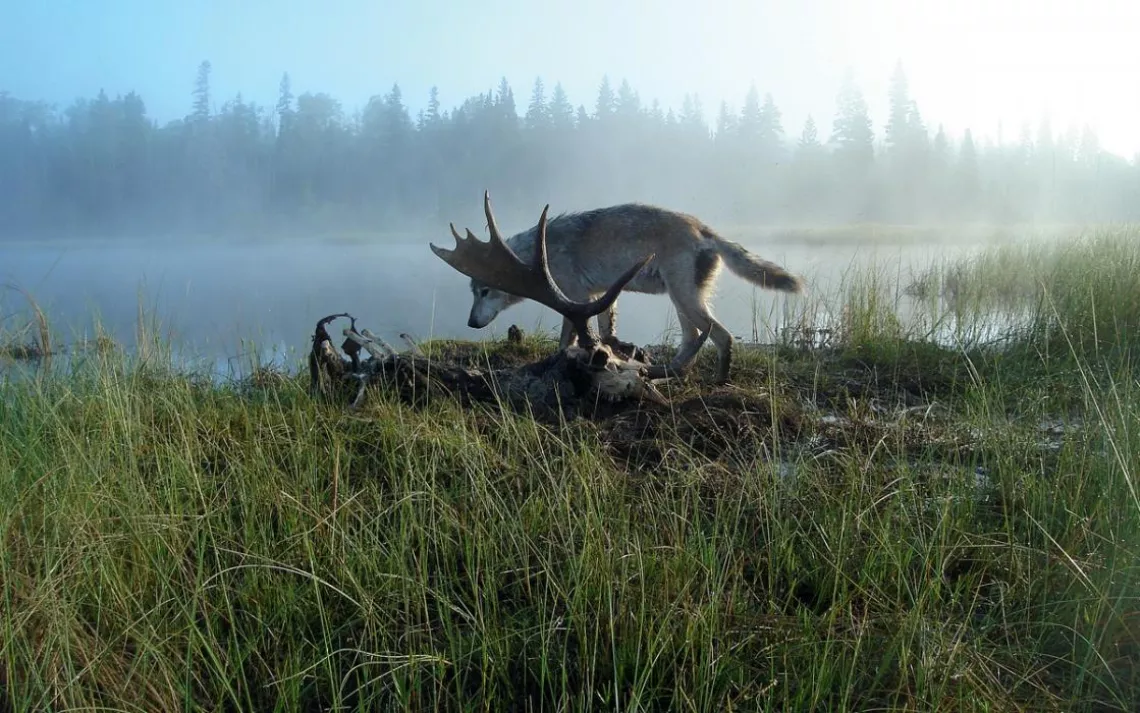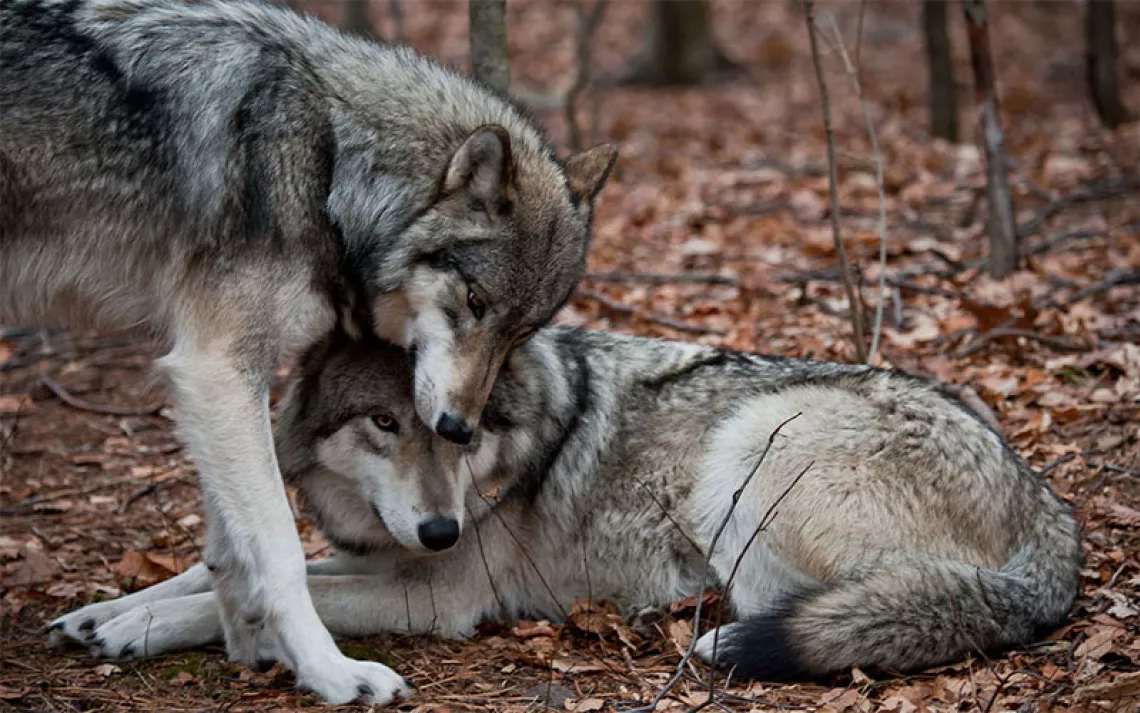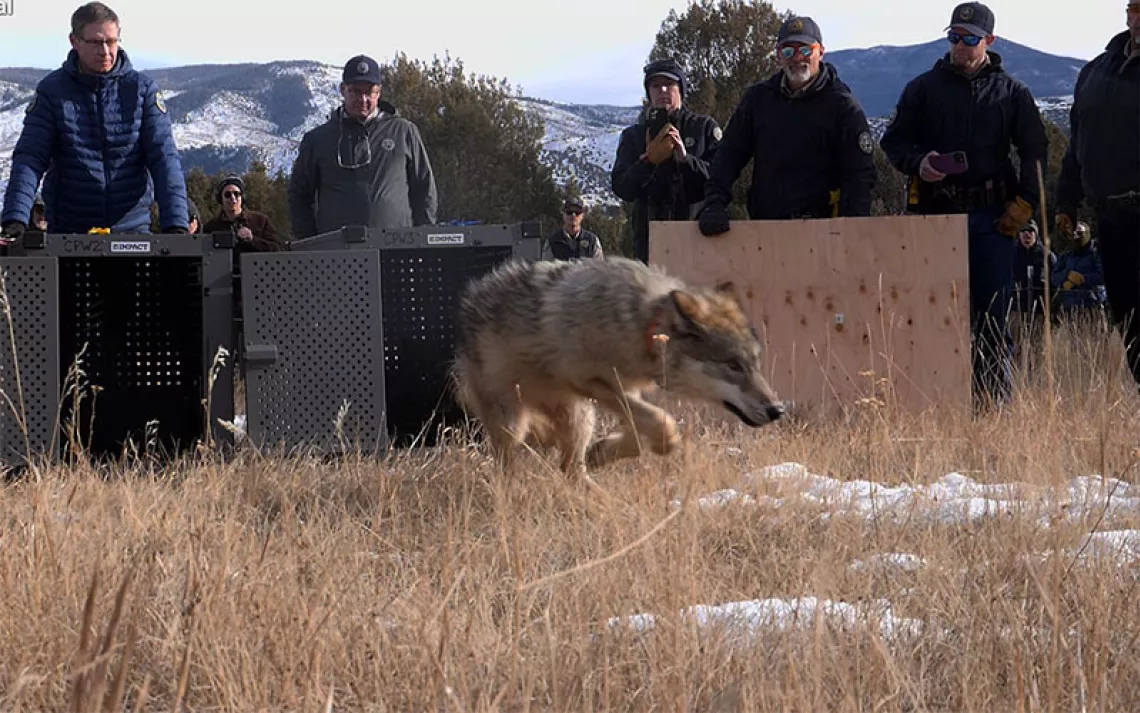Is Bringing New Wolves to Isle Royale National Park "Restocking the Zoo"?
Sometimes wilderness just can't take care of itself

The alpha male of the former Chippewa Harbor pack | Photo by Rolf Peterson
IN THE MIDDLE OF THE LAST CENTURY, before President Lyndon B. Johnson signed the Wilderness Act, a debate raged among American conservationists over wildlife in national parks. A. Starker Leopold, son of the pioneering ecologist Aldo Leopold, had been tasked with developing a wildlife management plan for the parks and concluded that the National Park Service ought to try to re-create "a reasonable illusion of primitive America." Preservationist Howard Zahniser, the primary author of the Wilderness Act, disagreed, arguing that Leopold's approach posed "a serious threat to the wilderness within the national park system and indeed to the wilderness concept itself." Humans should not try to manipulate wilderness, Zahniser wrote. We should be "guardians, not gardeners."
Zahniser's position eventually won out and was incorporated into the Wilderness Act. But that didn't settle the debate, which continues to this day. The temptation to tinker is strong—especially now, in an era of rapid climate change—and sometimes irresistible. Case in point: the spring 2018 decision by the National Park Service to reintroduce up to 30 wolves into Michigan's Isle Royale National Park over a five-year span so the population there can survive.
For nearly 70 years, Isle Royale—a 132,000-acre, federally designated wilderness in Lake Superior—has been famous for its wolves and their role in keeping the island's moose population in check. Wildlife biologists have spent entire careers monitoring the dynamics of the animals' rising and falling populations. For decades, Isle Royale was a textbook example of "nature in balance."

Moose arrived on Isle Royale only in the past century | Photo by JIM BRANDENBURG/MINDEN PICTURES/National Geographic Creative
Until it wasn't. In recent years, biologists have concluded that without human intervention, the wolves of Isle Royale are doomed. By last summer, only an elderly, grossly inbred pair remained, incapable of reproduction. In September, Park Service biologists began capturing wild wolves in the Great Lakes region and relocating them to the island; the agency expects to transplant up to eight wolves this fall. Park superintendent Phyllis Green says, "It's about hanging on to an ecological system that's probably been integral to the park since its creation."
IT'S DUSK ON ISLE ROYALE. I've just tucked into my sleeping bag when I hear a commotion at the shore. It sounds like ducks but is too guttural for dabbling waterfowl. Then I hear hooves churning the water, and I scurry out of my tent.
Just down the rocky shore, one of Isle Royale's nearly 1,500 moose is leading her newborn calf across Lane Cove. She makes belchlike grunts, encouraging the young one, who is falling behind. The calf's ears flip and flop as it bleats and digs valiantly at the still-icy late-May water. I watch in the growing darkness, aware that it was likely my presence that spooked the moose, until their sounds blend with the yodeling loons' and fade into the depths of the cove.
For now, a moose couldn't be born in a better place. Isle Royale is about as remote as you get in the contiguous United States. The 45-mile-long island, surrounded by a constellation of 450 outliers, is accessible only by boat or seaplane, is open to visitors only six months of the year, and has been off-limits to hunting since 1931, when Congress established it as a national park. Isle Royale was rolled into the National Wilderness Preservation System in 1976. Only 28,000 people came here last year, making it the least visited park in the Lower 48. There are no roads, only the network of footpaths I am exploring.
This is perfect moose habitat. Lake Superior's perennially cool waters check the warming temperatures that have caused moose numbers on the mainland to plummet. Balsam fir and spruce mark the lush lowlands that run in a series of parallel gutters between bedrock ridges. Patches of wizened maple, birch, and aspen grow on glacier-carved spurs that rise up to 600 feet. And, for the moment, the moose's only predators are almost gone.
Without wolves, however, the moose may be doomed as well. "Moose are capable of basically destroying the forest," says Rolf Peterson, who has worked on the island since 1970 and is the most well-known and vocal supporter of wolf reintroduction. He has urged the Park Service to take action for six years, since the wolf population began its sharp decline. He paints a bleak picture of the alternative. Already, he says, half of the island's balsam fir trees, a moose favorite, are at risk.
"If moose were to proceed on the current trajectory," Peterson says, "they will increase to great numbers and go through die-offs. The end result is a totally degraded forest."
THE CELEBRATED PREDATOR-PREY dynamic on Isle Royale is not an age-old phenomenon. The Park Service acknowledges that both moose and wolves are relative newcomers, having arrived of their own accord only in the past century. Before that, for 3,500 years, woodland caribou nibbled the delicate lichens that hang like whiskers from the branches of the white spruce, while Canada lynx, the island's largest predator, pursued snowshoe hares in the brush.

A wolf pair at Rock Harbor in 2009 | Photo by Rolf Peterson
In the 18th and 19th centuries, early European settlers and fur traders slaughtered the caribou, on both Isle Royale and the mainland. (Today, only small remnant herds remain on a few isolated islands on Lake Superior's Canadian side.) Meanwhile, clearcut logging and wildfires on the mainland precipitated a population explosion of moose, which thrive in regenerating forests.
Moose are impressive swimmers, and it was only a matter of time before the big ungulates navigated the 15 miles of open water separating Canada and Isle Royale. By 1915, there were an estimated 200 on the island. The new competition, together with continued hunting by humans, quickly did in the remaining woodland caribou, which disappeared completely by 1925. Trappers finished off the lynx around the same time. The moose population swelled to as many as 5,000 in 1928, then crashed to only 171 by 1943. Around 1949, wolves colonized the island by way of a winter ice bridge from Canada. It is believed that three animals established a population that, until recently, averaged around 25 and held moose numbers in check.
During the early days of the modern American environmental movement, Isle Royale's wolves emerged as an icon of the wild. Their interactions with moose provided generations of ecologists with critical insights that helped shift the popular perception of wolves away from fairy-tale menace. In a few short decades, humans elevated them to keystone status, a defining feature of the island park. It was as if the wolves had been there forever.
AT ISLE ROYALE'S MAINLAND headquarters in Houghton, Michigan, Superintendent Green shows me some of the hundreds of letters she was bombarded with as the dismal fate of the island wolves became apparent. Concerned citizens overwhelmingly supported a wolf reintroduction, often characterizing the predators as hallmarks of a "healthy" ecosystem. Some of the biggest names in conservation cheered the Park Service's plan to intervene: The National Parks Conservation Association called the decision "an important step for wildlife," and Michael Robinson of the Center for Biological Diversity asserted that "having wolves makes [Isle Royale] more wild and natural."
That was also the opinion of 21 fifth graders from Grand Rapids, whose cursive letters to Green included colorful drawings of sunny skies, flowers, wolves, and moose. "If something doesn't happen, Isle Royale will be lost forever," one wrote. "I ask you to bring in more wolves."
More than anyone else, Dave Mech is responsible for popularizing the notion that wolves keep Isle Royale's ecology in balance. Mech was a 21-year-old wildlife ecology senior at Cornell University when he was recruited to do graduate work on an island he'd never heard of in Lake Superior. He began his study in 1958, when about 20 wolves roamed Isle Royale alongside an estimated 538 moose. Mech's adviser, Purdue University's Durward Allen, saw the island as a perfect natural laboratory: Predator and prey were far removed from the disruption of human development and other confounding variables on the mainland.
Mech, now 81 (he still does wildlife research for the U.S. Geological Survey and serves as an adjunct professor at the University of Minnesota), fondly recalls those days when he was a young student and was free to explore "a mystical place" in all seasons of the year.

An aerial view of Isle Royale's rockbound northeastern tip and surrounding islands in Lake Superior | Photo by Conor Mihell
"I could do whatever I wanted out there," he adds. "I focused on counting the wolves, counting the moose, and studying predation."
Between 1959 and 1961, Mech spent 65 weeks on the island. In the winters, he surveyed wolf and moose behavior from overhead in a 90-horsepower, two-seater airplane on skis. In the summers, he racked up 1,500 miles of hiking. "The wolves appear to have kept the moose herd within its food supply, culled out undesirable individuals, and stimulated reproduction," he wrote in a 1966 National Park Service report. He described the relationship between wolf and moose as a state of "dynamic equilibrium." Mech concluded that the island's moose were "probably one of the best 'managed' big-game herds in North America."
To the public, his observations were a revelation at a time when wolves were still regarded by many as bloodthirsty killing machines. "Everyone thought wolves could kill anything," Mech says. "Well, I discovered they didn't. They were only successful in about 7 percent of attempts on moose. They couldn't take the big, healthy animals, so they took the old ones, calves, and animals with cysts in their lungs and poor bone structure."

Moose and wolves are dramatic, but they're only part of the ecological wealth of Isle Royale. | Photo by PHIL SCHERMEISTER/National Geographic Creative
Mech's grad-student project would become the world's longest-running predator-prey study. At the time, Mech says, he had no reason to believe that the equilibrium he witnessed wouldn't last forever: "Nobody was thinking about inbreeding. The study of wildlife genetics was totally undeveloped. It seemed like everything functioned well."
As recently as 2013, Mech encouraged a "wait and see" attitude regarding reintroduction. "I thought there was still a chance the [last remaining] pair of wolves could produce offspring and revitalize the population," he says. "I was proven wrong." He came out in favor of reintroduction in 2017, calling it an "unparalleled opportunity" for researchers to carefully select the next cohort of Isle Royale wolves based on sex, age, and (especially) genetics, and to equip them with tracking collars. According to Green, the Park Service will follow these parameters in the reintroduction.
"As a private citizen, I don't like government intervening and doing things in a national park unless it is to correct things we've done previously, such as eliminating wolves in Yellowstone," Mech says. Yet he encourages intervention at Isle Royale, predicting that reintroduction will allow scientists to discover new details about "genetics, wolf-moose relations, and the social organization of recolonizing packs."
"I think we need to do it," he concludes, "and that overcomes my personal conflict."

Map by Steve Stankiewicz
FOR OTHERS, HOWEVER, tinkering with nature by replenishing wolves at Isle Royale is a betrayal of the whole notion of wilderness. "It's a great idea, but it flies in the face of what wilderness means," says Roderick Nash, an environmental historian and the author of Wilderness and the American Mind, long considered the authoritative chronicle of the U.S. environmental movement. "It's not just something to please us. The Wilderness Act tells us to take ourselves out of the picture. It doesn't matter what humans want. What matters is what evolution wants. What wilderness wants. Change is the only constant."
The Michigan Chapter of the Sierra Club has not taken a position on wolf reintroduction, believing that the Park Service has not done enough investigation. But Marvin Roberson, the chapter's conservation representative, is openly critical of the Park Service's plan. Roberson—a forest ecologist who has visited Isle Royale 20 times—sees the wolves' plight as a biological reality of an isolated habitat, a prime example of what ecologists E.O. Wilson and Robert H. MacArthur identified back in 1967 as "island biogeography." They forecast a capricious existence for large predators, along with reduced biodiversity, on geographically isolated landmasses, like, say, a remote island in North America's largest freshwater lake.
Island biogeography explains why Isle Royale supports a fraction of the mammalian species found on the neighboring mainland. It's an elegant predictive tool that has informed wildlife conservation—revealing, for example, the need for natural corridors to connect protected areas. Island biogeography also dovetails with Charles Darwin's observations of the emergence of new species on islands like the Galápagos; scientists now consider Isle Royale's red squirrels to be a genetically distinct subspecies of the mainland variety because of their millennia of separation.
Roberson fears that wolf replenishment will lock the Park Service into a dangerous "cycle of manipulation," forever supporting an ecological community that may not belong on Isle Royale. It eliminates the opportunity for a "novel ecosystem" to emerge natrally, Roberson says, and precludes options like resurrecting the original community of caribou and lynx. (The Park Service says that the reintroduction will be a one-time event.)
The Park Service was pressured into a knee-jerk reaction, Roberson believes—"one of the biggest in the history of the Park Service in terms of management strategy," he says. "It's making an active decision to change the ecological composition of an island. Why don't we just let an island be an island? Let's look at it as a confirmation of scientific theory instead of restocking the zoo with the animals we like."
Human restraint is central to the 1964 Wilderness Act, agrees Kevin Proescholdt of Wilderness Watch, a national advocacy group. "The National Park Service is acting like the Wilderness Act is just guidance that they can follow some of the time, not all of the time," he says. "We can't just ignore a statute because everyone likes wolves. As soon as we drop the wolves out there, wild ends. At that point, it's no longer wild; it's no longer self-willed. It will make Isle Royale less wild and less free, and that's not what the Wilderness Act intended."
TIMES HAVE CHANGED since 1964, Peterson says. Even on an island as remote as Isle Royale, he and his colleagues at Michigan Tech have shown, population dynamics are tangled with human actions. Around 1980, for example, a visitor to the island violated park rules and brought a dog, which transferred virulent canine parvovirus to the wolf population. It contributed to 36 wolf deaths over two years; Peterson identifies the outbreak as an acute contributor to the pack's demise. And he predicts that another human influence—climate change—will drastically reduce wolves' ability to recolonize the island naturally via wintertime ice bridges (although bridges have formed in two of the past five winters).
At the summit of Mt. Franklin, perched on a balcony of rock the morning after my moose encounter, I gaze across open water to Canada and consider what poet Gary Snyder calls the "post natural age." I'm deep in the wilderness, yet I still hear the sound of a distant diesel generator, powering the national park work center. In the past two days, I've observed pleasure boats buzzing in the harbors, battering the shoreline with their wake. Overhead, a parade of aircraft heads for the international airport at Thunder Bay. I wonder if "wilderness" is just a guise—a fabrication designed for human consumption in a country where the 2 percent of the Lower 48 devoted to it is roughly the same acreage as the area of pavement.
SUPERINTENDENT GREEN ADMITS that the wolf issue has been thorny, even within the Park Service, but says that she feels the agency has done due diligence. She says she hopes that the letters, emails, and phone calls she's received from the public reflect a deeper interest in all of nature and its myriad interconnections, not just the drama of predator and prey. Because, Green maintains, there is a lot more to Isle Royale than wolves and moose.
In 2011, a team of botanists identified a small patch of Isle Royale ragwort—an endemic plant found nowhere else in the world. The pine marten, a feisty weasel-like species thought to have been eliminated on Isle Royale by trappers, was recently rediscovered. The island's community of freshwater sponges and mollusks, she says, is the richest in the Midwest. As the island's wolves flirt with local extinction, the cisco, a trout species landlocked by glaciers in Isle Royale's lakes, has already disappeared from two of them owing to the warming water from climate change.
The decision to reintroduce wolves, Green says, was not taken lightly. It came down to keeping all of Isle Royale's components as they are right now, regardless of the twists and turns of the past. She thinks that such intelligent tinkering will ultimately make us better guardians of wild places. "We need to be observant and thoughtful," she says. "I think there's still a lot more to discover."
This article appeared in the November/December 2018 edition with the headline "A Reasonable Illusion."
Take a Sierra Club trip to Isle Royale, Michigan. Details at sc.org/adventure-travel.
 The Magazine of The Sierra Club
The Magazine of The Sierra Club



